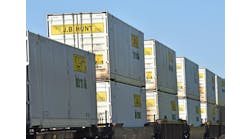A couple of related news items recently crossed my desk. The gist of them sent me scurrying for my plastic recycling bin. Both stories had a similar theme: degradable plastic. I thought this might be a good time to clean out that recycling bin and see what I could reuse on the topic of plastic that disappears.
Biodegradable or degradable plastic is not a particularly new idea. For the sake of this column let's skip the science. Accept the idea that plastic can degrade and it can biodegrade. The first turns the material into "plastic sand" and the second transforms it into natural elements. The terms are often misused.
The first news item reports that the French Assembly has passed legislation banning the sale and distribution of all plastic packaging material beginning in 2010. Well, not exactly all plastic packaging. Read closely and you'll see that it says if the plastic is biodegradable it can stay. The second news story features Wal-Mart. The retail Goliath has started using corn-based plastic packaging in its food preparation operations. The first evidence of this project (produced via a joint venture of Dow Chemical and Cargill) will be 114 million clear clamshell containers used for fresh fruits and herbs. Wal-Mart exec Matt Kistler said this will save the equivalent of 800,000 gallons of gasoline and reduce more than 11 million pounds of greenhouse gas emissions.
There are a number of degradable plastics on the market. Beyond loose fill and small containers, none that I'm aware of focus on transport packaging. Polylactic acid (PLA), the product produced by Dow Chemical and Cargill, has a lot of potential.
There's a bigger story here than just degradable plastic. The questions are: Should we choose degradable products, or should we choose durable products? My concern is that degradable plastic products only perpetuate the throwaway society we've become.
Here's the business case for turning away from degradable plastic products. For material handling managers it does not make good business sense to continue to buy something that's already been paid for. That's what happens if packaging is not reused or recycled. As the Reusable Pallet and Container Coalition (a trade association of businesses that manufacture reusable pallets and containers) points out, does it make sense to buy a new wheelbarrow every time you want to move a load?
Using degradable plastic, should it ever get to the point where containers and pallets can be constructed of the material, makes the least sense of all. Buying a wood pallet for $11 and using it three times, or a plastic pallet for $60 and using it 75 times, makes more sense than buying a degradable pallet (at whatever price) and throwing it away because you can.
The driving thought behind these degradable products seems to be that degradability is the right, or green thing to do. But sending the new biodegradables to the landfill is a waste of money and time. These plastics need to be treated like compost to degrade. Landfills are sealed to minimize oxygen and moisture.
The right thing to do is reuse what you've already paid for. Educate employees not to toss pallets and containers into the trash just because it's the end of the cycle. Any pallet or container, regardless of material, grows in value every time it's reused. Given the skyrocketing resin prices, and skyrocketing engineered wood prices following this summer's storms, reusing and recycling now make more sense than ever.



